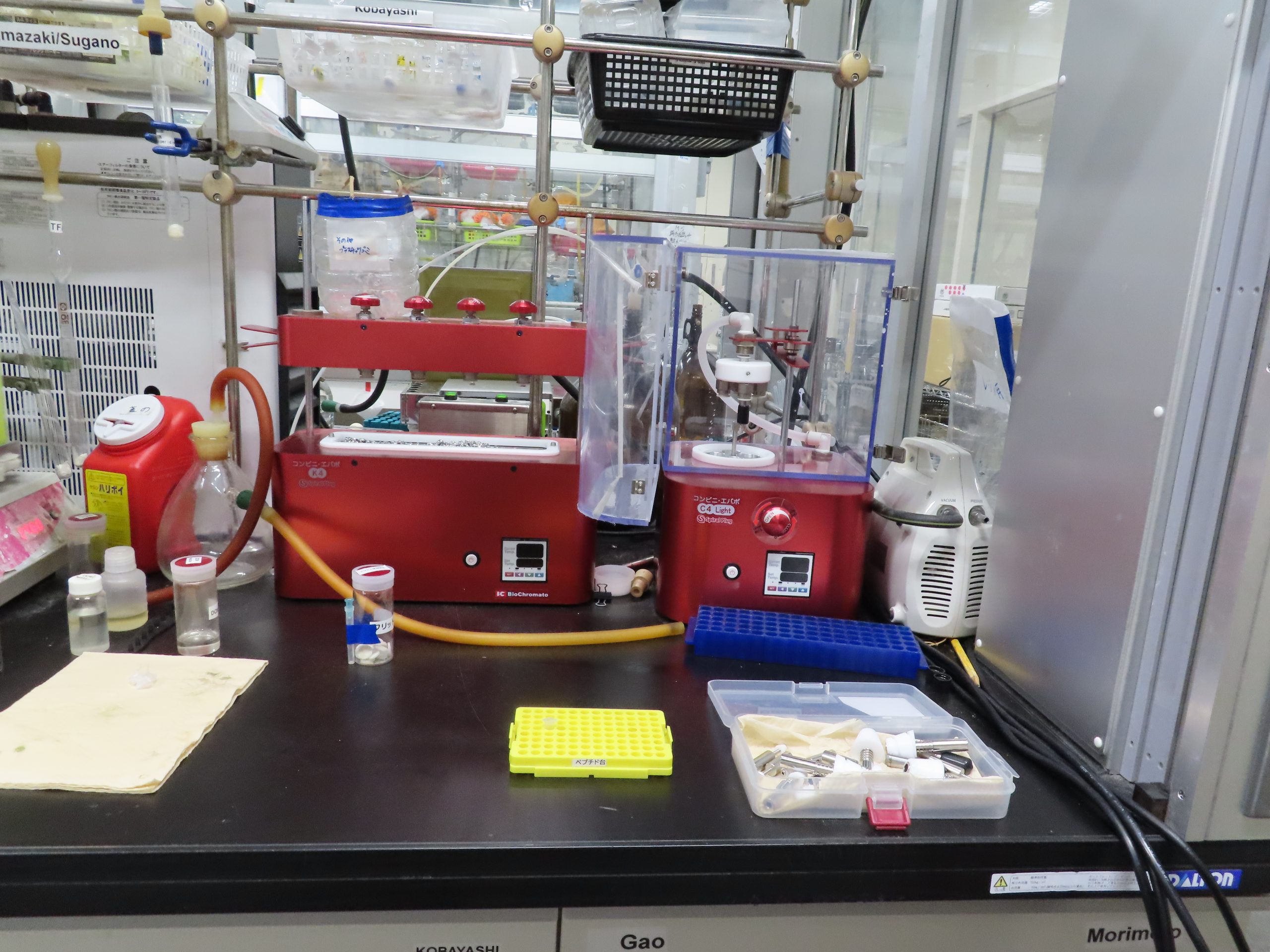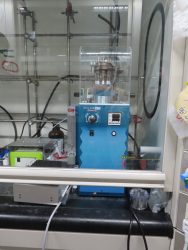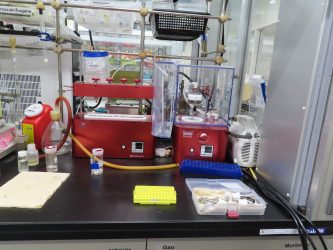Three models [K4, C1 with 4Kit, MT8] are used for each experimental system! We have eliminated the waiting list for the Smart Evaporators!
We spoke to Assistant Professor S from the Graduate School of Engineering at a university in Tokyo , who is taking on the challenge of designing biomolecules with excellent functionality, to develop understanding and control processes in the phenomena of life , which have previously gone undetected at the molecular level.

┃Topics
- The use of three models of Smart Evaporators has eliminated the waiting list for an evaporator!
- Use a variety of different sample containers by selectively employing different models with bead-type and block-type temperature control.
- Increase the number of simultaneous sample evaporation from 4 to 20.
(Four rotary evaporators [previously] → Four rotary evaporators + Smart Evaporators K4/C1 with 4Kit/MT8 [current])
┃Conditions for using Smart Evaporators
- Models used : K4, C1 with 4Kit, MT8
- Sample containers used : 9mL vials, microtubes, resin containers, etc.
- Solvents :
Dichloromethane/HFIP, mixed solvent 600 µL of 20% PBS and 80% acetonitrile/, TFE/dichloromethane, TFA/dichloromethane 100 µL–4 mL, 20%HFIP/DCM 5 mL, DCM 5 mL
┃Applications
- To measure and analyze crude solutions by NMR
- To transfer and store compound solutions in the vials.
- To replace solvents of molecular probe solution.
- To perform solvent distillation for excision and cyclic solutions from solid phase of peptides (and for subsequent application to LCMS and HPLC).
*Click here for a list of conditions of use

┃Reasons for introducing the Smart Evaporators and work after introduction
Before the introduction of the Smart Evaporator, the main methods of concentration were done using rotary evaporators [hereinafter referred to as Evaporation] and air drying.
There were four evaporators in use, but dozens of lab members were waiting for them to become available, so it was stressful to have to wait for their turn and work efficiency suffered. In addition, the extra task of fitting adapters to the rotary evaporators prior to performing evaporation was tedious.
Also, air drying took a long time.In the case of our lab, the number of samples was large and often small volume, so we were looking for an evaporator that could process multiple samples at the same time, A professor at our university introduced us to the Smart Evaporator, which I started to consider.
We have been using the Smart Evaporators and found that they are great for evaporating multiple samples simultaneously.
Currently, we use a total of three models, each is used for a different sample container, such as 9mL vials for the C1 with the 4Kit, microtubes for the MT8, and resin container for K4.

┃Reasons why the Smart Evaporator was chosen after consideration of other evaporators
Before implementing an evaporator, we extensively compared options from various companies. A key factor in our decision was an interview with Professor Yamaguchi and Professor Muto of Waseda University that we found in the customer’s testimonial on the BioChromato website, who had previously conducted research in the same lab as me. Their positive reviews significantly influenced our choice, and I felt reassured that the product would meet our expectations.
In fact, at the beginning of the demonstration, we tried evaporating dichloromethane and were surprised by how quickly it dried, even during the short time I was talking. After that, I was able to do a thorough evaluation and see how good it really is.
In terms of operability, being able to simultaneously concentrate multiple samples regardless of their dimensions, such as microtubes, vials and resin containers, is one of the things that makes the Smart Evaporator easier to use than other devices.
Initially, we considered the Smart Evaporator C10 since it can process 10 samples simultaneously. However, after we were shown examples of using a different model for each sample container type , we ultimately opted to use two models: the K4 and C1 with 4Kit.
The deciding factor in introducing the MT-8, which was launched a year later, was the compact design that could handle micro tubes directly.
<<Introduction history>>
July 2022: Implementation of the Smart Evaporator C1 with 4Kit and K4
March 2023: The MT-8 was introduced at the 143rd Annual Meeting Exhibition of the Pharmaceutical Society of Japan
July 2023: Implementation of the MT-8.
What was found after using the Smart Evaporators.
┃Impressions on actual use of Smart Evaporator
<Advantages>
- Simultaneous evaporation of multiple samples.
- No sample loss due to bumping.
- Evaporation of multiple samples in multiple vials simultaneously
- Simple operation and fast evaporation
- Evaporation of small volumes, such as 1.5mL Eppendorf tubes
- Can be used with a variety of tubes such as a 15mL tubes
<Issues>
- How to reduce gas consumption to prevent water contamination in high humidity environments or when concentrating anaerobic samples
- To improve the functionality to be able to adjust the height and pressure when concentrating multiple samples (K4, MT8)
- To improve the MT-8 to observe samples placed at the rear
- To improve the stability of the sample container when using beads (especially when using 1.5mL tubes).
Summary
Thank you very much, Assistant Professor S for taking the time out of your busy schedule to join us for an interview of this User's Voice and also thank you for implementing three types of Smart Evaporator.
We were told that our colleagues conveyed a sense of passion for the Smart Evaporator' from their demeanor during the interview. While we were humbled by the kind words from you, it was an honor to engage in discussions together and explore the possibility for improving and evolving our approach.
When you were considering the introduction, we noticed that you were conducting a comparative evaluation with products from several manufacturers, and we observed the serious intent to enhance work efficiency. With a strong desire to be of assistance in any way possible, we are truly pleased to have this opportunity to hear the your thoughts. We are very happy to realize that the Smart Evaporator has been useful.
During the pharmaceutical conference, we had the opportunity to introduce the MT8 to you. We received positive comments regarding its usability with microtubes and its compact design. It was very impressive that you promptly considered the MT-8 shortly afterward.
We are very pleased to have seen you use three different models of the Smart Evaporator depending on application.
The reduction of nitrogen consumption has been a longstanding issue that we have been addressing. Once improvements are made, we will promptly inform you. We will continue to strive to meet your expectations in the future, so we appreciate the ongoing support. Thank you very much."
■Interested in what Smart Evaporator is? You can learn from here!
